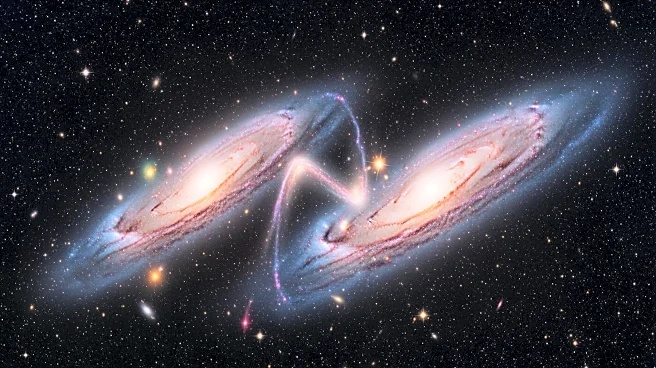What's Happening?
Astronomers have identified a massive bridge of near-invisible gas connecting two dwarf galaxies, NGC 4532 and DDO 137, located approximately 53 million light-years from Earth. This bridge spans more than
185,000 light-years and is accompanied by a record-breaking galactic tail stretching up to 1.6 million light-years long. The discovery was made using the Australian Square Kilometre Array Pathfinder (ASKAP) telescope during the Widefield ASKAP L-band Legacy All-sky Blind Survey (WALLABY). Researchers believe the bridge was formed by a close passage between the galaxies over a billion years ago, pulling neutral hydrogen from the smaller galaxy toward the larger one. The tail is thought to be stretched by ram pressure as the galaxies move through the superhot gas surrounding the Virgo cluster.
Why It's Important?
This discovery provides critical insights into the dynamics of galaxy formation and evolution, particularly in dense environments like the Virgo cluster. The presence of neutral hydrogen, a key component for star formation, in the bridge and tail suggests potential for new star creation. Understanding these structures can help researchers learn how galaxies interact and change over time, offering clues about the conditions under which galaxies may form stars. The findings also highlight the capabilities of the ASKAP telescope in uncovering hidden cosmic phenomena, contributing to the broader field of astrophysics.
What's Next?
Further analysis of the bridge and tail, as well as similar structures in the WALLABY data, could enhance understanding of galactic evolution. Researchers aim to compare these dwarf galaxies to others, like the Large and Small Magellanic Clouds, to study how such structures evolve with or without larger galactic partners. Continued exploration may reveal more about the redistribution of galactic gas and the varying conditions for star formation.
Beyond the Headlines
The discovery raises questions about the role of tidal forces and ram pressure in shaping galactic structures. It also underscores the importance of advanced telescopes in detecting faint cosmic features, potentially leading to new theories about galaxy interactions and the lifecycle of cosmic gas.











